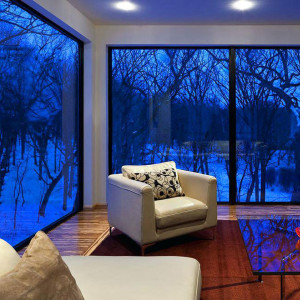| Kaveh Glass Industry Group |

| No Title | 0.02 MB |
| Registration Date | 30 May 2019 |
| Revision Date | 30 May 2019 |
| Share |
Construction Decoration
Low-E GlassControl of heat and high energy efficiency Decreases heating expenses Do not compromise on natural daylight and transparency Ensures maximum benefit from solar heat Approximately five times stronger than annealed glass against impact Minimum risk of injury; whrn broken it is divided into small pieces which are not sharp The definitions of the above table parameters: 1- Visible Light Transmittance: VT shows the percentage of light passing through the glass. This parameter is useful in evaluating the types of glass in supply of building light. 2- Ultra Violet Transmittance: UV shows the amount of ultraviolet light that enters inside the building. Obviously, because of the harmful effects of the radiation, the lower amount is better. 3- Solar Heat Gain Coefficient (SHGC): This parameter is known in some texts as G-Value, which expresses the transit of heat and energy of sun from the glass. The SHGC is numerically between 0 and 1. Lower SHGC means less solar heat travels through the window and vice versa. 4- Shading Coefficient: Shading coefficient is the solar factor factor (SF) of each type of glass to the solar factor (SF) is a single-walled glass with a thickness of 3 mm under the same conditions. This ratio is without unit and varies between 0 and 1. The ratio of the radiant energy of the sun entering the space through the window refers to the total energy flowing on the same level of the window as the solar factor (SF). SHGC = SC ×0/87 5- Heat transfer coefficient: U-Value is a parameter that shows the amount of heat transfer from any object, and is used to express insulation amount of glass. The smaller the heat transfer coefficient means less heat transfer and hence greater insulation.
Glass is one of the most consuming materials in the building, which allows light inside and the possibility of visual communication with the outside of the building. But due to its weak insulation properties, it has always been a problem in the cold and hot seasons. That's why in the past and even now, there are various types of shades and curtains in the summer to prevent the sun from coming into contact with light and intense heat, and in the winter, thick curtains are used to prevent the heat loss inside the building.
Today, with the advancement of technology, the common glass defects, especially in terms of waste and energy recovery, have been greatly improved. Low-E glasses or energy controllers come from this category of glass. This type of glass is produced by coating very thin layers on the flute glass with very advanced equipment.
Low-Emissivity or Low-Emissivity glasses translated into low-pass glass in Persian are glass that has a much lower heat transfer than ordinary glass and flute glass, and acts like a transparent thermal insulation. Due to the fact that a large area of the building's surface is made of glass, using these types of glass rather than conventional glass will greatly help to reduce the energy consumption of buildings. These types of glass are produced in different types and with different efficiencies.